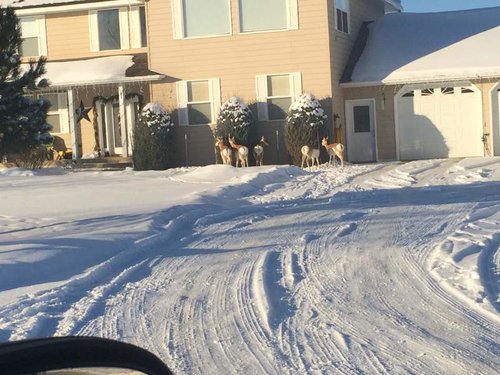Nameless Range
Well-known member
I know there are a lot of problems with feeding elk and deer to help them survive winters - like the spread of disease. But I am starting to feel that in limited instances it may be a good idea. My reasons being:
I'm not saying we are having one of those winters now and I am not saying I have a hardline position on this. And I'm not saying I support annual supplemental feeding or even feeding during a 10 year winter. But what about those 100 year winters that would impact deer and elk populations in a way that has not occurred since we filled our western valleys up with interstates and cities? I'm interested in other's takes when it comes to those 100 year winters.
The forecast is offering a bit of hope where I live, but even so, I think a chunk of the local deer population is already dead. Here are some pronghorn not acting like pronghorn in a struggle to survive.
- I don't buy the "let nature take its course" argument. We have built highways and cities in most of the historical wintering grounds of the mountain west
- Sure, winter kill happens, but what if a winter is a not a 10 year winter(like a 10 year storm), but a 100 year winter? As in, a winter like we have never seen since the North American Model was implemented. Somewhat analogous to the fires of 1910. We know what can happen in nature, it just isn't likely to happen in a given lifetime and hasn't in ours. It can take half a decade, if not more for populations to recover from a "normally bad" winter kill. Imagine a more extreme scenario.
- I'm not convinced that you couldn't have a near total die off if one of these "100 year winters" occurred.
- Would it not be worth it to supplement feed in one of these outlier winters to save a decade or more of hunting in a given area?
I'm not saying we are having one of those winters now and I am not saying I have a hardline position on this. And I'm not saying I support annual supplemental feeding or even feeding during a 10 year winter. But what about those 100 year winters that would impact deer and elk populations in a way that has not occurred since we filled our western valleys up with interstates and cities? I'm interested in other's takes when it comes to those 100 year winters.
The forecast is offering a bit of hope where I live, but even so, I think a chunk of the local deer population is already dead. Here are some pronghorn not acting like pronghorn in a struggle to survive.
Attachments
Last edited:





